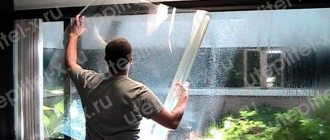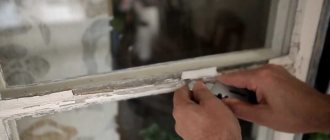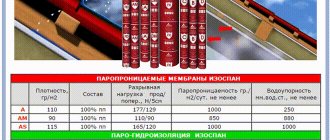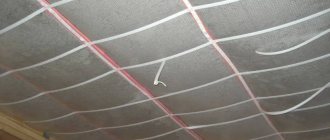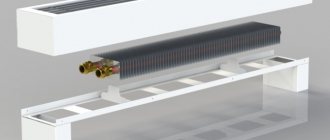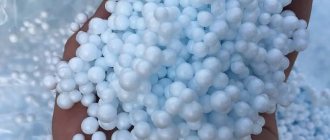Plastic windows are an excellent barrier to cold air in winter, but in severe frosts, if they are not insulated correctly and on time, problems may arise. Warm air will begin to go outside, and cold air, along with moisture, will come into the room and cause icing of the glass. To get rid of this, you can insulate the opening by sealing all the cracks. A fairly common method is to insulate a plastic window with film : it gives good results at minimal cost.
Energy saving film
This product is a polymer material. It is designed to prevent heat loss from rooms and prevent windows from “fogging up.” The market offers various types of these products, which differ in the degree of transmission of light rays and the thickness of the product.
In addition, the film has a plastic base, which makes it possible to prevent minor damage to the window glass. Also, this type of coating can be sold together with windows. You need to find out this on site from your sales consultant.
If the room has old-style windows, then you can apply this film yourself. This is all done simply and quickly. In this case, the room temperature rises from 3 to 8 degrees. Therefore, reviews about this film window insulation are only positive.
Anti-fog PET film for windows: pros and cons
Thermal-saving material has many advantages:
- Effective protection against cold. Your apartment or house will have a comfortable microclimate both in winter and summer; you won’t need to spend a lot of money on heating or buy a split system or air conditioner.
- Preserving the integrity of glass under minor mechanical impacts. If, however, the window breaks, for example, from a stone, the fragments will hang on the film and will not spill into the room. This reduces the risk of accidental injury.
- The applied coating does not create glare, protects textiles, floor coverings and furniture from fading when exposed to sunlight.
- Relatively low price, due to which you don’t have to spend too much on insulation. Installing such a film is cheaper than installing reinforced double-glazed windows with several cameras.
- Easy installation. On sale you can find self-adhesive window film, the application of which takes a minimum of time.
- A rich list of insulation films available on the market, produced by both Russian and foreign brands. In stores you can purchase products from A-Solar and other companies.
It should be noted that the use of insulating film for insulation is not without its drawbacks. The disadvantages include the following factors:
- It becomes difficult to keep indoor plants on the windowsill. The amount of ultraviolet radiation decreases, so they begin to wither. To solve the problem, you can install phytolamps that provide a 12-hour lighting cycle. The disadvantage of this option is the increase in energy costs, which makes the energy-saving properties of the film meaningless.
- Reduced effectiveness of thermal protection coating in spring and autumn. It prevents the room from heating by the sun's rays, and if the heating has already been turned off or has not yet been turned on, the room will be cold. In some cases, condensation also forms on the windows.
- Some films that create a “thermo” effect are capable of reflecting most radio waves, and cellular communications will work poorly in the room.
Film characteristics
This product has many positive qualities. Such as:
- Protecting the glass surface from damage. Since the product is made of polyethylene terephthalate (PET). This ensures that the window, when the film is glued to it, becomes durable and resistant to external and internal damage;
- The product is easy to glue. Anyone can master the job of gluing film. This does not require any special skills;
- The film blocks infrared rays well. This is due to the material with which this product is coated (silver and chromium-nickel composition). Therefore, all the heat remains in the room;
- The film does not in any way affect the transmission of daylight from the external environment. Those. with gluing of the product, the rooms will not be deprived of lighting.
Do you want to insulate a window? - Wash him!
Heat leaves our apartments not only due to drafts, but also goes outside in the form of infrared radiation.
Ordinary glass, being transparent to visible light, has a low level of transparency to infrared rays that transmit heat.
But contaminated glass, losing transparency in the visible part of the spectrum, significantly increases it in the infrared spectrum. Therefore, to preserve heat, it is enough to simply wash the window before the start of the cold season.
However, it wouldn’t hurt to do this in the spring either, so that less radiant heat penetrates into the apartment in the already hot summer.
The window should be washed inside and (necessarily!) outside with a product based on ethyl or ammonia. This will allow, firstly, to clean grease stains, which is especially important for the kitchen, and, secondly, to avoid stains left by dissolved salt in the water, remaining after the moisture evaporates.
In addition to the glass, we also need to wash the frames - we will glue seals, insulation, etc. on them. It doesn't stick well to dirt and falls off quickly. You don’t want to re-stick the seal in the middle of winter with the windows wide open?
Variety
The film differs in the type of pasting. The market offers three varieties of this product.
- Self-adhesive film. This product is easy to stick on any window. The main thing is to prevent the formation of bubbles and jammed areas when working with it. To do this, it is better to use a thick fabric and smooth out defects as necessary.
- Thermal film for window insulation. To secure it you will need thermal tape and a hair dryer. The product is attached with thermal tape, so that there is a gap between the film and the glass. Then all this is heated with a hairdryer and the product fits perfectly on the glass.
- Film without adhesive surface. This product is very easy to use. Attaches to window glass with a simple soap solution. Somewhat reminiscent of car tint. Despite its low cost, it is in no way inferior to the above-mentioned heat-saving products. It also retains heat and has a long service life.
Advice! Experts advise window coverings to be carried out exclusively in autumn or winter.
Overview of species
Architectural thermal film is transparent, it is used on glass windows of buildings, buildings and cars. The usual one does not have transparency; it is placed under suspended ceilings, wall panels, laminate and parquet, and hidden under the trim (upholstery) of the car interior. Both of them separate owners and/or workers from the heat outside in the summer, and retain most of the heat in the winter. In both cases, air conditioning and heating costs are significantly reduced.
Conventional (ceiling and wall, underfloor) thermal insulation film is made on the basis of the following materials:
- foamed polyethylene;
- fibrous polypropylene;
- Mylar fiber or fabric.
Based on the method of applying the heat reflector, the film is divided into the following types:
- foil layer;
- a composite layer obtained by spraying.
Foil in damp rooms is subject to accelerated destruction. Because of this, foil penofol or fiber is not used in baths and saunas, bathrooms, toilets and in the kitchen. The spraying is protected by a thin, microscopic layer of plastic; metal (aluminum) dust particles do not deteriorate. The heated spraying is slightly fused into the polymer base at the production stage. This is a higher technology than foiling, the observance of which is carefully monitored in factories.
Thermal film for walls and floors - stenofon - is similar to ordinary penofol. It has a porous or bubbly structure
It is placed under a decorative covering, which makes it impossible to avoid heating the wall panel from inside the room, but this is not as important as the actual escape of excess heat through the wall to the outside
Self-adhesive
This subtype is similar to the film used for the screen of a smartphone or tablet. For clear gluing, without air bubbles under specks and fluff, the room is thoroughly cleaned and all “dusty” things and objects are taken out. To protect the adhesive side from dust and moisture during transportation, a protective layer is applied to it by the manufacturer. The production of “self-adhesive” is a technology that requires ultra-clean factory conditions; the same cleanliness is ensured at the consumer's site.
It is difficult to paste this film yourself - one distortion, and it is difficult to remove wrinkles, since removing and re-sticking the same piece of film will dramatically affect the transparency and attractiveness of the window or glass. This film is glued starting from any of the corners, gradually pulling off the protective layer. Tinting a car requires no less care than gluing film to the windows of a house or building.
Heat shrink
Heat shrink option - film for window frame. It is secured with double-sided tape. An air gap is formed under it, preventing heat from quickly leaving the room. The initially glued heat-protective film resembles crumpled polyethylene. To straighten it, direct hot air from a hairdryer onto it - now the stretched material looks neat.
Sources
- https://veka-slide.ru/okna/energosberegayushchaya-plenka-na.html
- https://KotelSibir.ru/okna/termoplenka-dlya-okon.html
- https://srub-ets.ru/dveri-okna/termoplenka-na-kupit.html
- https://TalbaMas.ru/okna/teplootrazhayushchaya-plenka-na.html
[collapse]
How to use
Based on reviews from customers and professionals, this product is glued only in the cold season, and removed in the spring. If you carefully separate the film from the window, it can last for more than one season.
The main thing is to protect this item from prickly objects during use. Those. It is not advisable to place flowers such as cactus and other such plants with sharp thorns or needles on the windowsill. And also protect the film from mustachioed prankish cats.
Price
The cost of the material is influenced by several factors, the most important one was mentioned above. The rest are:
- Manufacturer of heat-saving film - German and Polish versions are often more expensive than domestic ones;
- Canvas size - larger materials are cheaper (in terms of size-price ratio).
Countries producing heat-saving films for windows:
- South Korea;
- China;
- Türkiye;
- Ukraine;
- Russia;
- Germany;
- Poland;
- Other.
Disadvantages of the product
The film also has negative sides that will help the buyer not make a mistake with his choice.
So, the disadvantages of the product:
- It is not recommended to stick the product on windows whose window sills are filled with indoor flowers. Since PET transmits little sunlight and plants begin to wither over time;
- The film does not allow heat to pass through during the warm season. This can make the house damp and cool;
- The product interferes with the normal transmission of radio waves. As a result, the operation of equipment (telephones, modems and radios) begins to malfunction.
Important! Modern high-quality windows do not allow heat to pass through from the inside. Therefore, there is no point in spending money on additional insulation of windows with film.
What is heat-saving film?
Window film for heat preservation is a thin film material that reflects infrared radiation. Reflectivity is achieved through metal spraying. The base for the film is polyethylene terephthalate. This is a fairly durable plastic that resists tearing well. Thanks to this, it provides additional protection for the glazing.
Special phytolamps will help compensate for the lack of any part of the spectrum - make sure that they are equipped with ultraviolet LEDs. Without them you won't get the full spectrum.
The metal coating applied to the heat-saving film reflects infrared radiation in the opposite direction. If it comes from outside, it is reflected outward, if from inside, then inward. In the winter season, IR rays created by heating devices will be reflected from the glazing and remain indoors. In summer we will observe the process of reflection of solar IR rays towards the street. The rooms will be warm in winter and cool in summer.
At the same time, the heat-saving film prevents the penetration of solar ultraviolet radiation. There is nothing critical for a person in this regard, although his skin is accustomed to perceiving the entire solar spectrum. As for plants, they may react by wilting. They need the full spectrum to stay green and produce offspring. If you are engaged in plant growing, select a window without film for green spaces.
Film behavior in the off-season
The summer heat is gone, the sun is weak, but the heating is not working yet. People want comfort - they need to turn on the heating, although it is still very early. And in this situation, heat-reflecting film on windows becomes a disadvantage. The thing is that it does not transmit infrared radiation, which could provide a little free heat. And in the spring and autumn periods it would be useful.
There are two ways out of the situation:
- Turn on full heating at least at a minimum so that the house is not damp and cold.
- You can use electric heaters, but in this case you need to be prepared for high energy costs.
What to do is up to you to decide.
Film installation
The energy-saving device does not require special knowledge when installing it. The main thing is to follow the instructions and tips for attaching it to the window glass.
Here you will find step-by-step instructions for pasting regular film, which is attached to window glass using a soap solution.
- To begin with, thoroughly wash the window with glass cleaner or the old method, using warm water with ammonia. The result from the latter remedy is in no way inferior to a commercial aerosol. Then wait for the window to dry completely.
- After this, alcohol or solvent is applied to the glass. This is a mandatory action for better fastening of the product. Take measurements of the glass unit. Advice! For regular users of this product, I advise you to cut the film a little larger than the parameters of the window glass, using a sharp stationery knife.
- Next, apply a soap solution to the glass and immediately begin pasting the film, otherwise the soapy substance will begin to dry out. And then you should not expect any effect from the product. The film begins to be glued from the top of the glass, gradually lowering the product down and smoothing it with a dry cloth. Advice! It is recommended to level the film from the center to the edges of the window. This will avoid unnecessary swelling on the product.
- The final step is to attach the insulation to the window using a regular hair dryer. The film is completely smoothed out. The result is an excellent window insulation that will not let heat out of the room and will increase the room temperature by 3-5 C.
Important! Shrink and self-adhesive films are difficult to attach to the window yourself. Therefore, before purchasing this product, you should think carefully about which film is suitable for the individual requirements of the customer.
Window care
Outdated or damaged film must be replaced with a new one. If it is glued to the frame, then you just need to peel off the tape and remove the material. The structure is then thoroughly washed and wiped dry. Some models are glued directly to the glass; removing them is a little more difficult. The lower corner is carefully pryed off with a stationery knife and torn off with a sharp hand movement from the window.
The insulated structure must be carefully looked after. You can wash the glass only five days after gluing the film. Wipe the material with a microfiber cloth or cotton cloth. You should not use aggressive chemicals; just make a warm solution of water and soap.
Where to buy the product
Thermal film is a fairly common product for preserving heat in the house. Over the past decade, this product has won the love of many customers. As a rule, the question of where to buy film for window insulation does not arise very often among buyers.
After all, the product can be purchased in an online store at a very affordable price. As well as wholesale and retail warehouses of building materials and hypermarkets of construction goods, they offer many options for thermal film from various manufacturers and different price categories, ranging from economy class to premium class products.
Conclusion
Heat-saving film is a material with a transparent texture that effectively protects rooms in a house, apartment or office from heat loss. Its use allows you to reduce heating costs by up to 30%, which is especially important in the winter season. On sale you can find products both on a self-adhesive basis, and those applied using a soap solution or creating a “third glass” effect. It is quite possible to cope with the installation yourself, especially if you have the tools and follow the instructions in detail. Some manufacturers offer film application from the factory, which is important when ordering new windows.
Did you like the article? Tell your friends:

